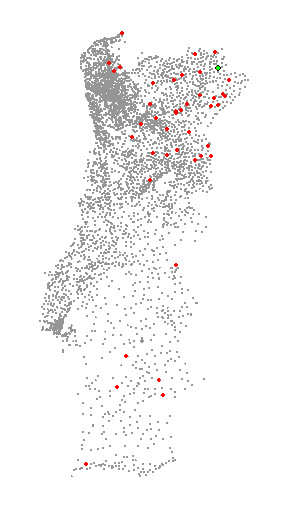 This is an Excel scatterplot. Each point is one of the 4200 Portuguese civil parishes. The green point shows the active parish and the red ones some parishes that may have a similar profile. Of course, if you select a different parish the red set also changes.
This is an Excel scatterplot. Each point is one of the 4200 Portuguese civil parishes. The green point shows the active parish and the red ones some parishes that may have a similar profile. Of course, if you select a different parish the red set also changes.
I like this idea of displaying geographic coordinates in a scatter plot and by that be able to see some (very basic) geographic patterns. Just by plotting the coordinates you get an idea of how the territory is structured and you can start asking questions (“why is the north so different from the south?”). By providing some more data (color coding the data points) we can add complexity to our questions.
If you think there may be a spatial pattern in your data and you (or the users) can’t have access to GIS software, or you just don’t want to learn another application, this technique could come in handy.
I presume you’ve seen ZIP Scribble Maps:
http://eagereyes.org/Applications/ZIPScribbleMap.html
Robert Kosara of EagerEyes.org has found intriguing patterns by connecting zipcodes in ascending order on a map. Your approach is similar, with different uses, but made me think of Kosara’s maps.
Very nice and useful – will you share the details of how to do this?
/Niklas
Hi, i’m very interested in how you set up your “poor man’s GIS” in Excel? I’m finding it very difficult in converting geographical cordinates into a 2D (x,y) cartesian plane..
All you need conversion-wise can be found here.
You could convert Lat:Long into UTM coordinates